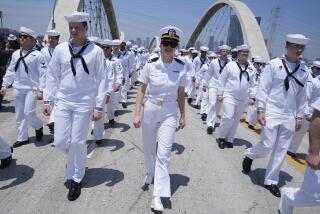Bridging the 12 Months of ’88 : Engineers Honor Spans on Calendar
- Share via
The American Society of Civil Engineers, whose calendars honor landmark architectural and engineering achievements, is devoting its 1988 issue to a sampling of the nation’s best-built and best-loved bridges.
The structures, representing each calendar month, were selected for their geographic dispersion and impact of the color photographs provided by the Historic American Engineering Record, said Herbert R. Hands, the society’s manager of historic activities.
Usually, he said, bridges come to public attention only when new ones are built, old ones collapse or famous ones are relocated.
“Fortunately, the negative situations rarely occur, but these masterpieces of design and engineering are often taken for granted,” he added.
Several Landmarks
Several of the bridges in the engineers’ calendar have been designated National Historic Landmarks, and some have also been named specifically as National Civil Engineering Landmarks.
Leading off as the January span of the month is San Francisco’s famed Golden Gate Bridge, revered in romance and song, which attracted hundreds of thousands of people to its 50th anniversary celebration last May.
“Most of us at ASCE rate the Golden Gate Bridge, completed in 1937, as the most beautiful bridge in the world, both for its engineering and design quality as well as its spectacular setting,” Hands said.
The landmark bridge held the record (4,200 feet) as the longest main-span suspension bridge until 1964. Built under the design and construction direction of Joseph B. Strauss, its chief engineer, Golden Gate’s 746-foot-high towers weigh more than a million pounds.
Another calendar bridge, the Tunkhannock Viaduct, completed in 1915 in Nicholson, Pa., appears to be a “poem of arches” of reinforced concrete and, when put in service by the Delaware, Lackawanna & Western Railroad, it was the largest of its kind.
Covered Bridge
The extraordinary Bridgeport Covered Bridge built over the South Fork of the Yuba River in California in 1862, is the longest single-span, covered bridge west of the Mississippi River. Its design is described as a Howe truss with reinforcing arch.
The handsomely proportioned concrete-reinforced Gervais Street Bridge, 1,415 feet long, carries vehicular as well as pedestrian traffic over the Congaree River between Columbia and West Columbia, S. C.
The George Washington Bridge, which links New York City with Fort Lee, N. J., was planned, designed and constructed in 1931 by civil engineer Othmar H. Ammann and upon completion, its 3,500-foot center span virtually double the length of its longest predecessor.
Smaller but not less spectacular is the Big Black River Bridge of the Midsouth Rail Corp., built in 1917 near Bovina, Miss. This 1,031-foot bridge has five concrete arches, three of which are 135 feet long; it is considered one of the outstanding examples of multiple-span concrete arch bridges widely erected by American railroads in the early part of this century.
Other Calendar Bridges
The bowstring-arch bridge at Fort Laramie, Wyo., known as the North Platte River Bridge; the Riverside Avenue Bridge in Greenwich, Conn.; the Smithfield Street Bridge in Pittsburgh; the mid-Hudson Bridge in Poughkeepsie, N. Y.; the Wire Bridge in New Portland, Me., and the Fort Keogh Bridge in Custer County, Mont., are other structures featured in the calendar.
Last but not least, December’s entry is the legendary Brooklyn Bridge, completed in 1883, and the longest suspension bridge in the world at the time. Designed by John A. Roebling and built under the supervision of his son, Washington Roebling, it was also the first to employ steel cables and trusses.
The Engineering Record, a program within the National Park Service initiated by the engineering society and the Library of Congress in Washington, records and preserves through photographs, drawings and historical data the significant architectural and engineering heritage of the country.
The records are transmitted to the Library of Congress and maintained there for public use. More than 1,550 structures have been documented to date, resulting in 17,500 data pages and 21,800 photographs, Hands said.
More to Read
Sign up for Essential California
The most important California stories and recommendations in your inbox every morning.
You may occasionally receive promotional content from the Los Angeles Times.










